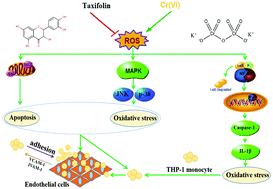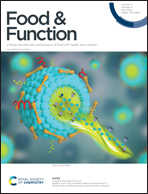A study on the protective effects of taxifolin on human umbilical vein endothelial cells and THP-1 cells damaged by hexavalent chromium: a probable mechanism for preventing cardiovascular disease induced by heavy metals
Abstract
Hexavalent chromium [Cr(VI)] which is a kind of heavy metal with strong oxidizing ability can induce cardiovascular disease (CVD), while taxifolin can protect cells and organisms against suffering from oxidative stress. In this study, the inhibitory effects of taxifolin against Cr(VI)-induced cell damage in human umbilical vein endothelial cells (HUVECs) and THP-1 cells were investigated. Cr(VI) could increase the phosphorylation of p38 and JNK, regulate the expression of Bax and Bcl-2 in both cell lines. Meanwhile, the Cr(VI) stimulation led to an increase of the expression of ICAM-1 and VCAM-1, and upregulated the adhesion of THP-1 cells to HUVECs. Furthermore, Cr(VI) could induce the activation of the nuclear factor kappa B (NF-κB) signaling pathway, the accumulation of p65 in the nucleus, and the increase in the phosphorylation of IκB and the expression of cleaved caspase-1 and IL-1β in THP-1 cells. However, taxifolin could reverse the effects by inhibiting the activation of mitogen-activated protein kinases (MAPKs) and NF-κB signaling pathways, regulating the expression of apoptosis-related proteins, and alleviating the adhesion of THP-1 cells to HUVECs. Our findings demonstrated that taxifolin was a potential agent to prevent endothelial dysfunction, monocyte inflammation and cell adhesion induced by Cr(VI).

- This article is part of the themed collection: Food & Function Recent HOT articles


 Please wait while we load your content...
Please wait while we load your content...